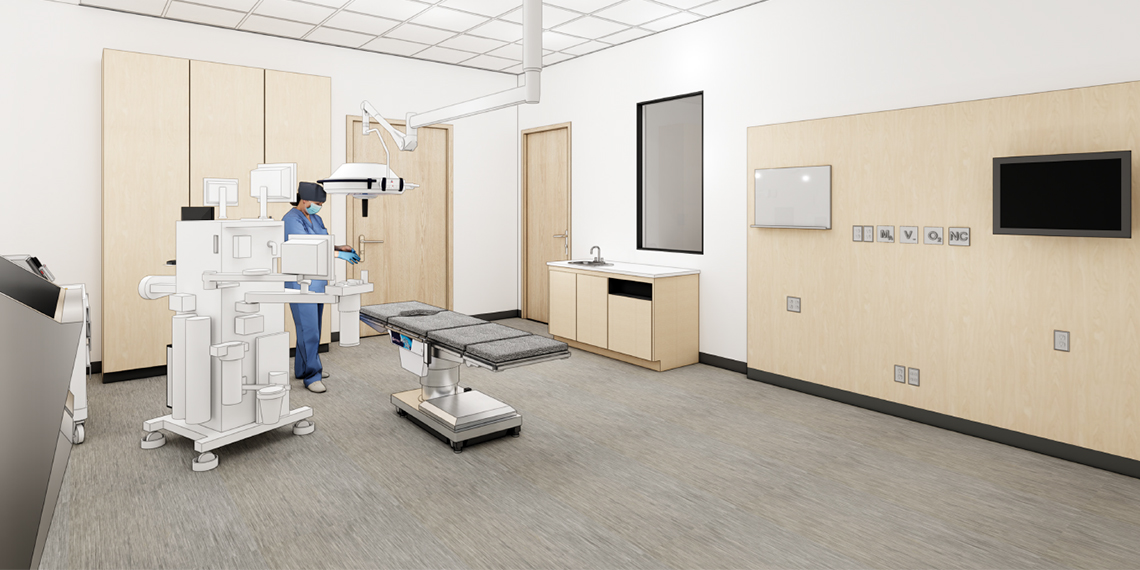Gonzaga to Expand High-demand Nurse Anesthesia Program

New space accommodates more students to meet urgent regional and national health care needs
Advanced education for anesthesia providers began in 1977 when Gonzaga partnered with Providence Sacred Heart Medical Center to offer a Master of Anesthesia – the only such training available in Washington. In 2015, it morphed into a Doctor of Nurse Anesthesia Practice (DNAP); it continues to be the only credentialed program in the state. Last year, the Gonzaga-Providence collaboration tied with Yale University for No. 22 in the nation for “Best Nursing-Anesthesia Schools” by U.S. News and World Report’s Best Grad Schools rankings.
For many years, enrollment in Gonzaga's DNAP has been highly competitive with far more applicants than spots available.
Fortunately, the development of the UW-GU Health Partnership with the University of Washington School of Medicine in 2016 – and completion of its four-story building on Spokane Falls Boulevard in 2022 – allowed for future growth to meet needs related to health care access throughout Eastern Washington. GU is building out more than 8,700 square feet of undeveloped space on the facility’s fourth floor to accommodate DNAP and nursing program expansion, with completion scheduled for the Summer 2026 to welcome the next class of DNAP students who begin at that time. This is made possible with the support of Dean Allen and the Emerald Initiative which owns the partnership building.
For Providence, growing anesthesia education is part of the organization’s workforce development initiatives – “not just for today, but for the future,” says Susan Stacey, chief executive for Providence Inland Northwest. “This partnership has a long history of growing anesthesia providers for our whole region, and we believe investing in its continued growth is really important to the future of patient care across Eastern Washington.”
Dan Getz, chief medical officer for Providence Inland Northwest, says the Sisters of Providence who built Sacred Heart Medical Center and a network of health care facilities, “have always been great about identifying needs in the community and investing in those needs.”
Getz says there just aren’t enough anesthesiologists, so the training of nurse anesthetists has been essential, not only for the larger urban hospitals, but especially in rural communities with smaller critical access hospitals. Additionally, the role of CRNAs administering anesthesia under the supervision of an anesthesiologist reduces the cost of health care.

Gonzaga’s School of Health Sciences Dean Julie Wolter notes, “as the only certified registered nurse anesthetists (CRNA) program in Washington and one of very few in the West, we serve a critical health need, and this partnership and building expansion will allow us to continue to grow and address the critical shortage of anesthesia needs of the region.”
“One of the things we’ve always done well is to identify good partners,” Stacey adds, “and Gonzaga is one of those. The two are better together.”
“We are pleased to be able to better meet the demands of our region through the expansion of programs where there is a critical shortage while also being able to provide a Jesuit education for even more students who want to pursue careers in health care,” says Mia Bertagnolli, interim provost. “Bringing Gonzaga's DNAP program into the Health Partnership building provides these students with greater support services that foster retention and long-term engagement, enhanced opportunities for mentorship with both Gonzaga and UW faculty and peers, and distance learning capabilities to support rural and nontraditional students.”
Further, the proximity of the DNAP program to Eastern Washington University’s Rural Initiative Dental Education (RIDE) program in the Health Partnership offers opportunities for interdisciplinary training in anesthesia for outpatient settings, Wolter notes.
“This marks the beginning of the next generation of health and medicine at Gonzaga,” says Katia Passerini, GU president. “It brings real solutions to areas of need the University has identified with regional partners for several years, and I’m thrilled to see these strategies moving ahead for the benefit of our students and the broader community.”
About the School of Health Sciences
Nursing education began at Gonzaga in the 1940s when students from St. Luke’s and Sacred Heart schools of nursing came to earn their bachelor’s degrees. The program became an official Department of Nursing in 1978, and in 2013, Nursing and Human Physiology became its own school. In 2023, Gonzaga changed the name to the School of Health Sciences to reflect growing needs for broader fields of study, and added a major in public health.
About the UW-GU Health Partnership
The University of Washington School of Medicine and Gonzaga University formed a Health Partnership in 2016 with a vision to improve health and prosperity throughout eastern Washington by transforming medical education, research and innovation. The combined strengths of each institution – deep community roots and world-class health and medical education – and the vast network of students, faculty and health care professionals is creating an impact by preparing the next generation of health care professionals to advance discovery and develop new ways to care for patients.
About Providence
Providence is a not-for-profit Catholic health care ministry committed to providing for the needs of the communities it serves – especially for those who are poor and vulnerable. In Eastern Washington, the Providence network of services includes Providence Sacred Heart Medical Center, Sacred Heart Children’s Hospital, Providence Holy Family Hospital and Providence St. Luke’s Rehabilitation Medical Center – all nationally recognized for quality care, as well as two critical access hospitals in Colville and Chewelah. It also includes a full continuum of services under Providence Medical Group – Providence Medical Park in Spokane Valley (a comprehensive multi-specialty center), three urgent care centers, home health, assisted living, adult day health, skilled nursing care, and over 90 specialty and primary care clinics throughout Eastern Washington. Providence Medical Group includes more than 850 physicians and advanced practitioners. Its medical staff includes primary care providers, surgical subspecialists, and medical specialists. For more information, visit www.providence.org.
- Academics
- School of Health Sciences
- Doctor of Nurse Anesthesia Practice (DNAP)
